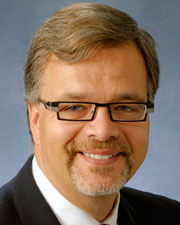KU scholar discusses origins of doomsday myth
LAWRENCE — They've built underground bunkers, stockpiled food and collected tools and weapons in preparation for doomsday.
But come Dec. 21, will the work these "survivalists" put in pay off?
Unlikely, says John Hoopes, anthropologist at the University of Kansas and author of scholarly articles debunking the 2012 myth, including a chapter in "2012: Decoding the Counterculture Apocalypse," edited by Joseph Gelfer and published by Equinox Publishing.
For nearly a decade, Hoopes has studied the speculation surrounding this predicted collapse of civilization, rooted in a myth that Dec. 21 marks the end of the ancient Maya calendar.
What the Maya Long Count calendar does show is that the end of the 13th b'ak'tun is approaching. A b'ak'tun represents a period of 144,000 days.
However, "there is no ancient Maya prophecy about this being the end of the world," Hoopes said. In fact, the Maya projected dates that stretched well beyond the 13th b'ak'tun, including the anniversary of a 7th-century Maya king's coronation in 4772 A.D.
So who is responsible for spreading this myth?
The mass media have profited from producing an array of books, TV shows and documentaries based on the 2012 Doomsday prediction, Hoopes said.
About 2,000 titles touching on the subject have been published. The TV series on 2012 survivalists, "Doomsday Preppers," is in its second season on the National Geographic Channel.
Unlike radio host Harold Camping's biblical "end times" predictions in 2011, Doomsday 2012 has been discussed for much longer, Hoopes said.
The myth also isn't based on any particular religion, which widens its worldwide appeal.
"What makes it different from other Doomsday predictions is that we've known about it for more than 100 years," he said. "We've known this date since the 1890s."
In 1897, American journalist Joseph Goodman was first to decipher the Long Count system and publish his findings. After that, other scholars added their own interpretations about the destruction they believed would accompany the end of the 13th b'ak'tun.
In the 1960s, New Age circles and a burgeoning tech-geek subculture renewed interest in the 2012 Doomsday prediction, particularly in places such as San Francisco. The Bay Area produced some of the nation's first "computer nerds" around this time — and it was also a place where marijuana and LSD use were on the rise, Hoopes said.
Today, the Internet and social media have allowed 2012 disaster rumors to spread faster and further.
"Global digital networks made it possible to know something about it, no matter what part of the world you're in," Hoopes said.
Hoopes first took interest in the 2012 topic after attending a Doomsday lecture at the Burning Man festival in 2003, he said.
"I had a feeling it was not just going to be a fringe thing," Hoopes said. He believed the 2012 Doomsday predictions would eventually attract more mainstream followers, too.
Bleak as Doomsday may seem, the literalist interpretation relieves humans of the responsibilities of solving world issues such as climate change and poverty, Hoopes said.
As for the Doomsday preppers, Hoopes thinks the presence of film crews might provoke some survivalists to behave more dramatically in front of the camera.
"People will be extremists to get on TV," he said.
